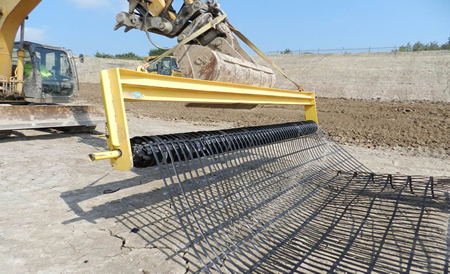
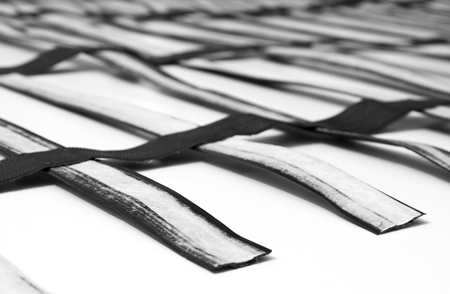
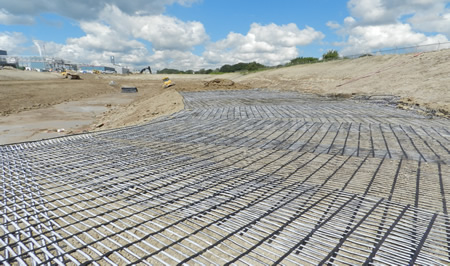
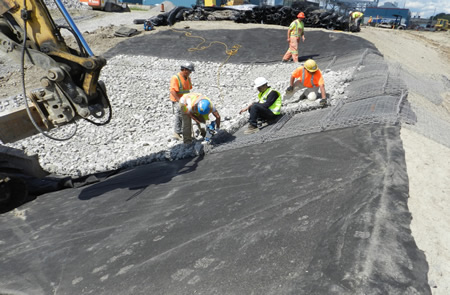
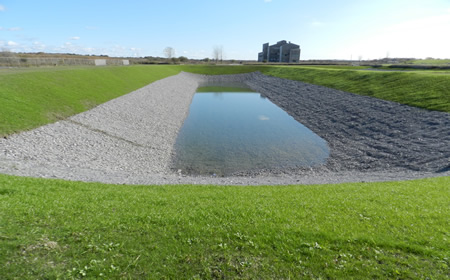
By Maccaferri – A unique geogrid has played an integral role in enabling a large industrial facility in Niagara (Ontario, Canada) to expand its production facility.
Stormwater and clean process water from production would be kept in retention ponds before gradual release into nearby watercourses. Three ponds were required to handle this expansion. Engineers working on the project had detailed the large retention ponds with side slopes of 2H:1V. The ponds were 7m deep with an expected permanent water depth of 4m.
Despite these relatively shallow side slopes, the native clay soils would not reliably maintain these slope angles especially when the ponds were full of water. Due to the size of the ponds and excavation required, the owners wanted to limit the use of imported fills to build the ponds and attempt to reuse the onsite clay soil as backfill for the 2:1 pond slopes. This would embrace sustainability by reducing the import of granular materials and the disposal of unsuitable cohesive soils.
However, the project team knew that before the fine-grained clay soil could be considered reliable and safe, reinforcement would be needed.
REINFORCEMENT & DRAINAGE
As part of the design considerations, the unique ParaDrain® 50/15 geogrid was evaluated. ParaDrain® is a dual-function geogrid. It not only reinforces soils but provides drainage at the same time and in a single product roll. Each longitudinal strap of the geogrid has an integral drainage channel covered with a geotextile to prevent clogging by fine particles. These channels ‘wick’ water from the surrounding soil that the grid is reinforcing, thereby dissipating the pore water pressure and improving the soil characteristics. This feature makes ParaDrain® particularly useful when reusing cohesive backfills as structural materials, as well as in environments where pore water pressure could cause stability issues.
The product is manufactured from high tenacity, multifilament polyester yarns that are co-extruded within a tough polyethylene sheath. The resulting polymeric strip has a proprietary channel shape which is covered with a non-woven geotextile to provide a drainage path.
Installed within compacted backfill in a reinforced soil slope, the geogrid provides a multitude of small drainage paths throughout the soil mass. This also enables the construction to proceed at a faster rate, as backfill consolidation (due to pore water dissipation) is accelerated – adding another project benefit to the design.
For the Niagara project, ParaDrain® provided an optimal solution.
PROJECT EXECUTION
Within the 7m-high reinforced soil slopes, the bottom 4m were reinforced with 9m-long ParaDrain® grids. The upper 3m were reinforced with 5m-long grids. The ParaDrain® geogrid enabled the backfill to consolidate quickly and the clays were placed and compacted at a rate of 0.5m per day.
Also of note on the site, the pond’s fine grained soils were at risk of wash-out, due to rising and falling water levels. An erosion protection solution was required. Maccaferri’s Reno Mattresses were used on the pond banks up to the expected permanent water level. Above this, a lower capacity erosion protection, MacMat® was used.
Reno Mattresses are made from hexagonal double twisted woven steel wire mesh (6×8 type) as per ASTM A975-11 2. Filled on site with rock, the mattresses form flexible, permeable and monolithic protection to hydraulic erosion. Unlike more rigid protection systems, the flexibility of “double twist mesh” mattresses is important in watercourses to accommodate the differential settlements so common in these dynamic environments.
MacMat® 10.4 Turf Reinforcement Mat (TRM) is composed of UV-stabilized nylon monofilaments, processed into a three-dimensional matrix. These TRMs have a high roughness, yet high (95%) voids ratio which is easily filled with soil by mechanical means, or naturally through accretion and sedimentation in channels. This creates the environment for vegetation to develop through the voids in the TRM.
The engineered solutions used in Niagara realized considerable cost savings through the re-use of on-site clays for structural fill rather than importing granular materials and disposing of the clay material. Once again, sustainability and economics were improved and design goals were achieved with geosynthetics.
PROJECT DETAILS
Contractor: Newman Bros. Contracting
Engineering: Ausenco Sandwell
Geotech: Inspecsol
Geosynthetics: ParaDrain® 50/15 geogrids, Reno Mattresses, and MacMat® 10.4 Turf Reinforcement Mats (TRMs) from Maccaferri
For more information about Maccaferri’s work, visit www.maccaferri.com.











